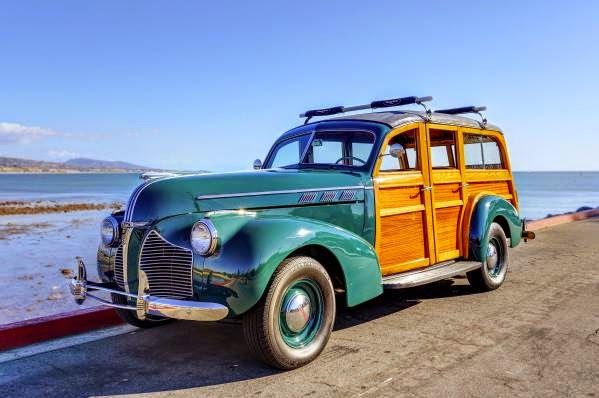Woodies came from the beginning of the auto era when train station depot hacks were used to cart luggage around from the station to people’s hotels. Later on the hack was enlarged and made into a useful carrier for commerce. Groceries, farms, produce vendors used them to carry their wares. At one point, the hack became fully enclosed and a proper station wagon complete with windows, doors, glass. At that point, the station wagon went from basic transporter to a status symbol.
We can look at Ford Motor Company for the evolution of the woodie. The idea for a fully enclosed woodie wagon came from Edsel Ford, Henry Ford’s own son. Edsel wanted a depot hack of a style that was more sophisticated than what was available at dealers. Edsel kept sharp eyes and close contact with custom coach builders and knew they were busy turning out custom depot hack bodies based on the best selling Model T chassis’. He knew there was a demand. With the new for 1928 Model A chassis, Edsel saw a chance to come through with a real looker. A fully enclosed woodie wagon for use at his own personal estate in Seal Harbor, Maine. Edsel had CW Avery make up a special body for a Model A. CW, who ran the Murray Body Division, could tool up the special bits needed to make a woodie wagon and did so.
Murray used finished panels supplied from Mengel Body in Louisville, Kentucky to make the woodie Model A for Edsel Ford. Murray built two of these Model A woodies, one for Edsel and one for himself to do product testing and shake out any faults. By the end of 1928, Ford had a ready to go plan for their own mass produced woodie wagon; the 1929 Model A, sold as Ford station wagon Model 150-A. It was a high spec model from the start with artificial leather seats, side curtains, tool roll, side view mirror, automatic windshield wiper and fuel gauge as standard equipment. Sales were stout from the beginning in spite of the Depression. It was a hit and GM wasn’t asleep at the switch coming up with their own woodie wagon. Chevrolet did depot hacks as well but their first attempt to do a copy like Ford started in 1928. It was similar in execution to the simpler depot hacks. It wasn’t until 1939 that Chevrolet went notably upscale with their fully enclosed Master Series and Master Deluxe wagons.
Pontiac had the jump on them by releasing their own enclosed station wagon in 1937. Featuring a Maple framed body with Mahogany panels, it was built by Hercules Body in Evansville, Indiana. Only offered as an 85 hp six cylinder, it cost $992. Pyralin side curtains or safety glass side windows were available while the windshield and front doors got glass only. From the cowl back, the body was all wood. Inside you got brown leatherette upholstery. The two colours offered were Golden brown or Wenonah maroon. This woodie debuted in March, 1937.
For 1938, Pontiac returned with a redesigned bolder horizontal finned grille, different hood panels and a higher price of $1,110. The wood panels also changed with a double framed door panel. Hercules Body supplied the bodies. Wenonah maroon and Carteret red stripes or Elkskin brown with Tacoma cream trim were the paint choices. Both years there were no cowl tag style numbers for these woodie wagons. Rubber floor mats were up front and thick carpeting was out back. New that year was a column shifted transmission and foot rests for the rear seat passengers.
For 1939, Pontiac had to deal with Chevrolet’s entry into the market place. Pontiac countered with a 3 seater wagon carrying eight passengers powered by their inline six. It used the Quality Six body series which was the small, Chevy A body size. It offered either Pyralin curtains or shatter proof glass built using Hercules bodies. A price cut to $990 was part of the deal. A new supplier of bodies was added; Ionia Body Co. supplied a different look featuring White Ash frames with Birch panels for a mono tone woodie look. Ionia cars had four frame ribs on the door panels. The Hercules bodies still used White Ash frames with contrasting Mahogany panels. The frame design featured two frame ribs with the spare tire cover optional and the rear bumper was split. The colour was Golden brown on Tacoma cream with brown leatherette interior.
The 1940 woodie still had no proper style number but was based on the Special 6 series, not the Torpedo or Deluxe. The drivetrain was basically the Deluxe Six but in a series 25 body. On the cowl tag it might say STAWAG. Selling for $1,105 you got a single spare tire well on the passenger side only, no dual sidemounts were available. Pontiac used both Hercules and Ionia bodies for 1940 and again the Hercules body was defined by the two-toned White Ash frames with Mahogany panelling while Ionia supplied a monotone appearance using Ash frames with Birch panelling. The interior door panels used dark Mahogany. The garnish trim was Continental Walnut. The 1940 wagon tailgate was two piece with the lower door hung parallel to the ground. The wagon had full running boards, a single tail-lamp and eight passenger rating.
Of note is the attractive wide fan grille on the 1940 Pontiac. The body proportions were just right and generally was a handsome car. The Silver Streak straight eight engine put out 103 hp from 248 and a bit cubic inches. Inside, the workmanship was superb. The headliner, instead of cloth, was a mass of perfectly varnished wood slats. The dash was chrome and painted steel with bits of lucite and early plastic here and there.
The seats were bench style and on the luxury model, the frames had chrome finish. As nice as the 1940 woodie was, a whole new era was about to start in late summer of 1940. Pontiac was redesigning their line-up for 1941. The cars had new appearances, names and models. At first glance it seemed as if little had changed. Once you look deeper, things appear and you realize changes had come to the woodie. The world was boiling over beyond America’s borders and before the year was over, life as North Americans knew it had changed forever. We’ll look at the Pontiac woodie’s evolution and post war progress in part two. Stay tuned!
Enjoyed the story or have questions? Write to pa67smith@ yahoo.com.

